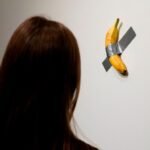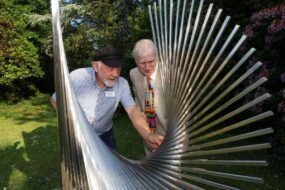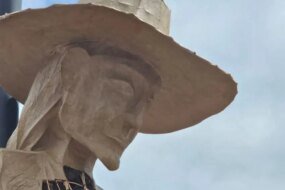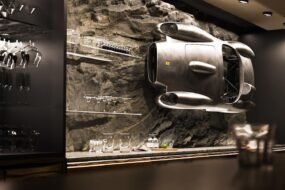
‘Students and visitors will learn about the process of listening, learning, and reflecting on shared history. And the ongoing impacts of colonization, with the goal of fostering healing and reconciliation,’ Steer said
An iconic roadside sculpture has been laid down, ready to return to the earth.
On Thursday, the Canadian Ecology Centre near North Bay hosted a gathering and a ceremony to lay to rest the Nibiising sculpture familiar to so many within the region. About 20 people endured relentless rain and an unseasonable chill to partake in the event, which also commemorated National Indigenous Peoples Day on June 21.
The purpose was to return the sculpture to the earth, following the west coast example of retiring old totem poles. The 26-foot-long sculpture now lies facing the sky, ready for the hands of time to reclaim it to the soil.
Elder Richard Assinewe from the Anishinabek Nation led the pipe ceremony, and the Shadow Drummers from Mattawa provided song afterwards.
For three decades, the Nibiising sculpture stood at the corner of Seymour Street and the highway 11/17 bypass, next to the former home of the Dionne Quintuplets, which is now the McKeown Gas Bar.
The sculpture was unveiled in September 1988. It was created by Florida artist Peter ‘Wolf’ Toth. At that time, Toth’s large-scale sculptures could be found in all 50 American states. The piece he created for North Bay was the first of Toth’s roadside sculptures to be installed outside of the USA.
The commission was made possible through the sponsorship of the Rotary Club of Nipissing in consultation with Nipissing First Nation. Tony Limina, the club’s president at that time, attended the event.
“It was an opportunity to finish the journey that we began back in 1988,” Limina said. “For me personally, it was the opportunity to see a Rotary signature project come to fruition that everyone was comfortable with.”
After decades standing tall, Nibiising had to be moved when the city sold the land it stood on in 2019. First North Enterprises moved the sculpture and has stored it since. “They were absolutely phenomenal,” Limina said.
When the sculpture was first moved from its original site, there were thoughts to relocate it. However, there were many cracks and fissures within the wood, and it was deemed unsuitable to relocate. Also, the depiction of the Indigenous man within the sculpture could be seen as outdated, verging on caricature.
The President of the Indigenous Friendship Centre, Maurice Switzer, noted, “It’s not considered appropriate that any people are depicted as mascots, or stereotypes, or caricatures. But that does not diminish the original good intentions the Rotarians had, and for that reason, Elder Assinewe was only too glad to give Nibiising a really important send-off.”
“This carving was considered appropriate for the time,” Switzer added. When preparations were made for the statue, the Rotary Club consulted with Nipissing First Nation, and all agreed it was a fine idea for a sculpture. “They did everything with good intentions and with good hearts. And times change.”
Bill Steer, the founder and general manager of the Canadian Ecology Centre, noted the centre was the perfect final resting place for Nibiising. The sculpture was laid on sacred ground, and there are signs detailing the sculpture’s history and journey.
Steer said, “It will be a cultural and natural educational opportunity to understand and build upon the Calls to Action within the 2015 Truth and Reconciliation report.”
“You couldn’t ask for a better educational resource when you think about teaching Indigenous culture, and ways and language. It’s a great resting place here in Samuel de Champlain Provincial Park, and thousands of students and people will see this and learn the story.”
He continued, “Students and visitors will learn about the process of listening, learning, and reflecting on shared history. And the ongoing impacts of colonization, with the goal of fostering healing and reconciliation.”
“This is an educational opportunity like no other,” Steer added.
Pioneer Construction transported it from North Bay to Mattawa, and then Kenalex moved the sculpture from there to its final resting place. It can now be found lying next to a trail about 200 feet behind the Canadian Ecology Centre.
“Let nature take its course,” Limina said. “This is a great opportunity to bring it back to Mother Earth in a respectful way.”
Limina emphasized the artist was included in the conversations leading to today’s ceremony, “Because we wanted to make sure the artist was comfortable with the journey we were bringing his piece of art to.”
“He was very pleased,” Limina said. Speaking of today’s event, Toth noted in a release, “It is a rebirth as opposed to a demise.”
David Briggs is a Local Journalism Initiative reporter who works out of BayToday, a publication of Village Media. The Local Journalism Initiative is funded by the Government of Canada.









